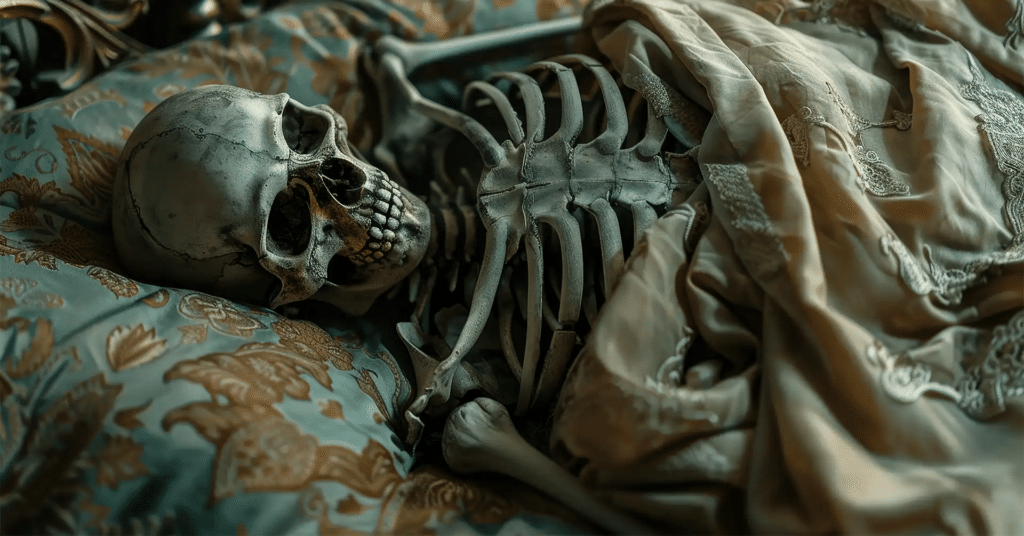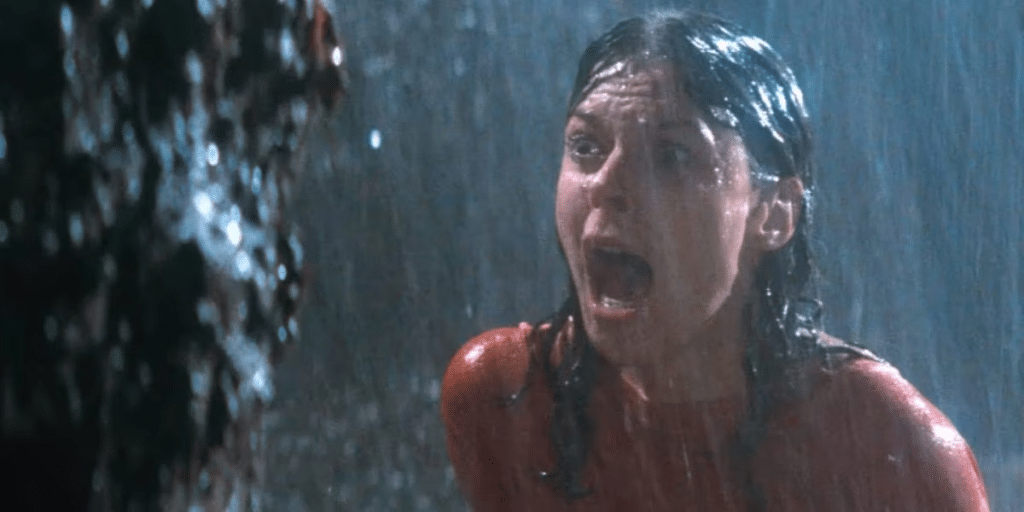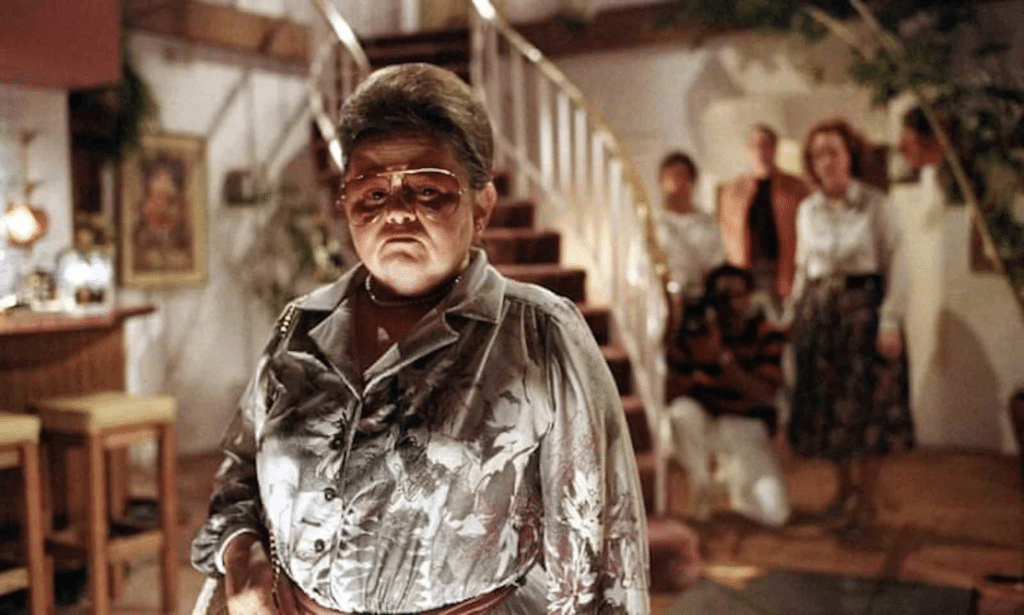The movie “Poltergeist”, released in 1982, is a famous horror film that scared many people. But there’s a creepy fact about this movie that’s even scarier than the story it tells. In one scene of the movie, the character Diane Freeling falls into a pool full of muddy water and skeletons.
The movie’s special effects team thought real skeletons would look more realistic on camera. At that time, it was cheaper to buy real skeletons than to make fake ones. These skeletons were bought from medical supply companies that got them from India.
Years later, in 1986, JoBeth Williams, the actress who played Diane, talked about this in an interview. She said she didn’t know the skeletons were real until after they finished filming that scene. This strange fact has become a famous Hollywood legend.
UNEARTHING THE REALITY: SKELETONS IN ‘POLTERGEIST’
The movie “Poltergeist”, released in 1982, shocked audiences not just with its scary story, but also with a behind-the-scenes secret. The filmmakers used real human skeletons in some scenes instead of fake ones.
This fact came to light years after the movie was made. It was especially surprising because “Poltergeist” was a big Hollywood movie, produced by Steven Spielberg, a famous director.
The use of real skeletons was most notable in a scene where the character Diane Freeling falls into a muddy pool full of bones. The actress, JoBeth Williams, didn’t know she was swimming with real human remains until after filming was done.
Budget Cuts or Bone-Chilling Props?
The decision to use real skeletons wasn’t about making the movie scarier. It was actually about saving money. In the early 1980s, it was cheaper to buy real skeletons from medical supply companies than to make fake ones.
These companies got the skeletons from India, where there was a practice of selling unclaimed bodies for medical research. The filmmakers thought using real bones would look more realistic on camera.
However, this choice raised ethical questions. Many people felt it was disrespectful to use human remains as movie props, no matter how realistic they looked.
Spielberg’s Eye-Opener and Crew’s Response

When Steven Spielberg found out about the real skeletons, he was shocked. He hadn’t known about this decision during filming. Many crew members were also surprised and upset when they learned the truth.
Some actors felt uncomfortable knowing they had worked with real human remains. It added a creepy feeling to an already scary movie set.
After “Poltergeist”, Spielberg made sure that fake props were used in his future horror movies. This experience changed how he approached special effects in his films.
The Impact Of Authenticity On Horror Filmmaking
The use of real skeletons in “Poltergeist” sparked a debate about authenticity in horror movies. Some people argued that using real items made the movie scarier and more believable.
Others felt that it was unnecessary and even unethical to use real human remains. They believed that good special effects could create the same scary feeling without crossing ethical lines.
This debate influenced how horror movies were made in later years. Filmmakers started focusing more on creating realistic props rather than using real items, especially when it came to human remains.
You might want to check: Stormi Steele Net Worth, Age, Husband, House, Zodiac Sign
TRAGIC RESONANCE: THE CAST FATE AFTER ‘POLTERGEIST’
After “Poltergeist” was released, a series of tragic events happened to some of the movie’s cast members. These events led to rumors about a “Poltergeist curse”.
The most shocking was the death of Heather O’Rourke, who played the young girl Carol Anne. She died unexpectedly in 1988 at the age of 12, just a few years after the movie came out.
Another actress, Dominique Dunne, who played the older sister in the movie, died tragically in 1982, the same year the movie was released. She was only 22 years old.
The Alarming Pattern Of Post-Production Fatalities
The deaths of Heather O’Rourke and Dominique Dunne were not the only tragedies linked to the “Poltergeist” movies. Several other people involved in the films died in the years following their release.
Julian Beck, who appeared in “Poltergeist II”, died of stomach cancer in 1985, before the movie even came out. Will Sampson, another actor from the sequel, died in 1987 after a heart-lung transplant.
These deaths, happening so close together, seemed like more than just coincidence to many people. It fueled beliefs about a curse associated with the movies.
Unraveling the Mystique of the ‘Poltergeist Curse’ Phenomenon

The idea of a “Poltergeist curse” became popular in the media and among fans of the movies. People tried to find explanations for why so many tragic events happened to people involved with the films.
Some believed it was because of the use of real skeletons in the first movie. Others thought it might be related to the movie’s story about disturbing a burial ground.
However, many people pointed out that these tragic events, while sad, were not necessarily connected. They argued that it was just a series of unfortunate coincidences rather than a real curse.
The Haunting Legacy Left By The Departed Actors
The deaths of young actors like Heather O’Rourke and Dominique Dunne left a lasting impact on Hollywood. Their tragic stories are often remembered when people talk about young stars who died too soon.
The “Poltergeist” movies became associated with these sad events. For many fans, it’s hard to watch the films without thinking about what happened to some of the actors after filming.
This legacy has made “Poltergeist” more than just a scary movie. It’s become a part of Hollywood legend, with its behind-the-scenes story sometimes overshadowing the film itself.
SUPERNATURAL OR SUPERSTITION: THE CURSE OF THE ‘POLTERGEIST’ FILMS
The idea of a curse on the “Poltergeist” films is a mix of fact and fiction. While there were indeed tragic events associated with the movies, calling it a “curse” might be an exaggeration.
Many people in the film industry say that accidents and tragedies can happen in any movie production. The “Poltergeist” series just had an unlucky string of events that got a lot of attention.
However, the notion of a curse has become a big part of the movies’ legacy. It’s often mentioned when people talk about cursed film productions or supernatural events in Hollywood.
Behind-The-Scenes Illness And Tragedy
During the making of the “Poltergeist” films, there were reports of strange illnesses and accidents on set. Some crew members got sick, and there were unusual equipment malfunctions.
One famous story is about JoBeth Williams, who played the mother. She said that pictures in her house would be crooked every day when she came home from filming, even though she straightened them each morning.
While these stories add to the creepy feeling around the movies, it’s hard to say if they were really supernatural or just coincidences that seemed spooky because of the films’ themes.
The Exorcism On Set: Fact Or Fiction?
One of the strangest stories about the “Poltergeist” curse is that an exorcism was performed on the set of “Poltergeist III”. This was supposedly done to remove any evil spirits.
The story goes that Will Sampson, an actor who was also a Native American shaman, performed the ritual. However, there’s no solid proof that this actually happened.
This tale shows how the line between fact and fiction can blur when it comes to movies, especially scary ones. People often want to believe in supernatural explanations for unusual events.
The Psychological Toll Of Horror Movie Production

Making horror movies can be stressful for the people involved. Actors and crew members spend a lot of time in dark, scary settings and thinking about frightening ideas.
This can affect people’s mental health. Some actors have reported having nightmares or feeling anxious after working on horror films.
In the case of “Poltergeist”, the young actors might have been especially affected. Playing scared all the time, even if it’s just pretend, can be hard on a child’s mind.
You may also know: Yahritza Martínez Net Worth, Bio, Relationship, Life Style
ON-SET HORRORS: FREAK ACCIDENTS DURING FILMING
During the filming of the “Poltergeist” movies, there were reports of strange accidents. While some of these might be exaggerated, they added to the creepy reputation of the films.
One famous incident involved a prop tree used in a scary scene. The mechanical arm that controlled the tree malfunctioned and nearly hurt child actor Oliver Robins.
These kinds of accidents can happen in any movie, but because “Poltergeist” was a horror film, they seemed more sinister to many people.
The Malfunctioning Clown Doll Incident
One of the scariest scenes in “Poltergeist” involves a creepy clown doll that attacks a child. During filming, there were stories about this doll moving on its own when the cameras weren’t rolling.
Crew members reported finding the doll in different positions than where they left it. Some even said they heard it making noises when no one was near it.
While these stories are probably just rumors, they added to the spooky atmosphere on set and fueled beliefs about supernatural occurrences during filming.
Fire Hazards And Uncontrolled Stunts
Some of the most dangerous moments during filming involved fire stunts. In one scene, actor Craig T. Nelson had to rescue the actress playing his wife from a fiery hole.
The fire in this scene got out of control, and Nelson actually got burned. This shows how real the dangers can be when making action-packed horror movies.
There were other risky stunts too, like when actors had to be pulled through ceilings or dragged across rooms. These scenes looked scary on film but were also dangerous to make.
The Real Dangers Behind The Camera

Making movies, especially horror movies with lots of special effects, can be dangerous. There are often real risks for the actors and crew members.
In the “Poltergeist” films, there were scenes with collapsing houses, exploding objects, and people being thrown around by invisible forces. All of these required careful planning to keep everyone safe.
Sometimes, despite all precautions, accidents happen. The pressure to make things look real on camera can lead to taking risks that might not be completely safe.
ENGAGING THE OTHERWORLDLY: SKELETONS VERSUS GHOSTS
In horror movies, filmmakers use different ways to scare the audience. Two common elements are skeletons and ghosts. Each of these creates a different kind of fear.
Skeletons are solid and real. They remind people of death in a very physical way. This is why using real skeletons in “Poltergeist” was so shocking – it brought a real element of death into the movie.
Ghosts, on the other hand, are usually shown as invisible or see-through. They’re scary because you can’t touch them or fight them in a normal way.
The Tangibility Of Terror: Skeletons In Horror
Skeletons have been used in horror stories for a long time. They’re scary because they’re a clear symbol of death and what happens to our bodies after we die.
In “Poltergeist”, the use of real skeletons made this fear even stronger. Viewers knew they were seeing actual human remains, which added an extra layer of creepiness.
Skeletons are often used in horror movies to create a sense of danger that feels very real and physical. They remind us that death is a real part of life, not just a scary story.
Ghosts In Cinema: Scaring Without Substance
Ghosts are different from skeletons because they’re usually shown as not having a physical form. This makes them scary in a different way – you can’t see or touch them, but they can affect the real world.
In movies like “Poltergeist”, ghosts are often portrayed through special effects. Filmmakers use things like moving objects, strange noises, or blurry images to show that a ghost is present.
The fear of ghosts comes from the idea of something that can hurt you but that you can’t fight back against in a normal way. This creates a feeling of helplessness that many people find very scary.
Audience Fears: What Truly Unsettles Viewers?

Different people are scared by different things in horror movies. Some find physical threats like skeletons or monsters more frightening, while others are more afraid of unseen dangers like ghosts.
The makers of “Poltergeist” tried to use both kinds of fear. They had scary physical things like the skeletons in the pool, but also unseen ghostly forces moving objects and taking people.
Recommended this post: Tucker Carlson Wife Heiress Net Worth
FAQ’S
Did the movie “Poltergeist” really use real human skeletons?
Yes, the 1982 movie “Poltergeist” used real human skeletons in some scenes, especially in the pool scene with Diane Freeling.
Why did the filmmakers use real skeletons instead of fake ones?
They used real skeletons because it was cheaper to buy them from medical supply companies than to make fake ones. They also thought real bones would look more realistic on camera.
What happened to some of the actors after the “Poltergeist” movies? Sadly, some actors died young. Heather O’Rourke, who played Carol Anne, died in 1988 at age 12. Dominique Dunne, who played the older sister, died in 1982 at age 22.
Is there really a “Poltergeist curse”?
Many people believe in a “Poltergeist curse” because of the tragic events that happened to some cast members. However, others think it’s just a series of unfortunate coincidences.
Were there any dangerous accidents during filming?
Yes, there were some dangerous moments. For example, actor Craig T. Nelson got burned during a fire stunt. There were also incidents with malfunctioning props, like a mechanical tree that almost hurt a child actor.
Final Thoughts
The movie “Poltergeist”, released in 1982, is famous not just for its scary story, but also for the real-life mysteries surrounding it. The use of real human skeletons in the film shocked many people and raised ethical questions. The tragic deaths of young actors like Heather O’Rourke in 1988 and Dominique Dunne in 1982 led to rumors of a “Poltergeist curse”.
While some believe in this curse, others see it as a series of sad coincidences. The movie’s legacy goes beyond its plot, touching on issues of filmmaking ethics, safety on movie sets, and the impact of horror films on actors and audiences. Today, “Poltergeist” remains a part of Hollywood legend, reminding us of the sometimes blurry line between movie magic and real-life consequences in the film industry.

With over 7 years of experience in the fashion industry, I oversee all back-end operations and bring a wealth of expertise to the role. My vision is for Fashiontris.com to be the premier online destination for the latest trends, and insightful articles related to the fashion world.











